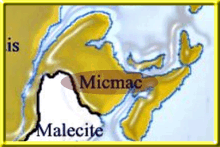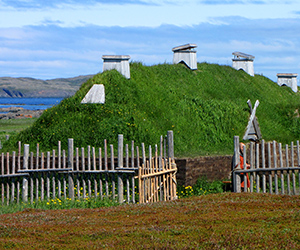CANADA HISTORY
Nisga'a

The Nisga'a people are an Indigenous Nation from the Nass River valley in present-day British Columbia, Canada. Prior to contact with Europeans, the Nisga'a people had a rich and diverse culture and history that was deeply rooted in their connection to the land and their ancestral traditions.
The Nisga'a people had a matrilineal society, where descent and inheritance were traced through the maternal line. They lived in large, multi-family houses and relied on fishing, hunting, and gathering for their subsistence. They also had a complex system of governance, with hereditary chiefs and councils that made decisions and resolved disputes within the community.
The Nisga'a people had a rich spiritual life, with a complex belief system that included creation stories, spirits, and ancestor worship. They held potlatches, which were important events for the community and were used to mark significant life events, such as births, deaths, and marriages, as well as to redistribute wealth and resources.
The Nisga'a people had a rich and complex spiritual belief system that was closely tied to their relationship with the land and their ancestors. Some of the key elements of their religious beliefs included:
Ancestor worship: The Nisga'a believed that the spirits of their ancestors were still present in the world and could be called upon for guidance and protection. They held regular ceremonies and offerings to honor and communicate with their ancestors.
Creation stories: The Nisga'a had a number of creation stories that explained the origin of the world, the creation of humans, and the relationships between different aspects of the natural world. These stories were passed down orally from generation to generation.
Spirits: The Nisga'a believed that the world was inhabited by a variety of spirits, both good and evil, who could have a profound impact on their lives. They held ceremonies and offerings to appease and gain the favor of these spirits.
Nature: The Nisga'a saw the natural world as being intimately connected with the spiritual world, and believed that the spirits of plants, animals, and other natural features had their own unique personalities and powers.
The Nisga'a people's religious beliefs were an important part of their daily lives and were closely tied to their cultural practices and traditions.
The Nisga'a people were primarily subsistence hunters, fishers, and gatherers, and their food and materials came from the abundant resources of their traditional territory in the Nass River valley in present-day British Columbia, Canada. Some of the key sources of food and materials for the Nisga'a people included:
Fishing: The Nisga'a people were skilled fishers who relied on the abundant salmon runs in the Nass River for a significant portion of their food. They used traditional fishing techniques, such as nets and traps, to catch salmon and other fish.
Hunting: The Nisga'a people hunted a variety of game, including deer, elk, moose, bear, and other animals, for both food and materials. They used traditional hunting tools and techniques, such as bows and arrows, to harvest game from the surrounding forests.
Gathering: The Nisga'a people gathered a variety of wild plant foods, such as berries, roots, and leaves, as well as materials for clothing, shelter, and tools. They had a deep understanding of the plants and resources in their territory and knew how to gather them sustainably.
Trade: The Nisga'a people traded with neighboring Indigenous Nations for a variety of goods, including food, materials, and cultural items. These trade relationships helped to build relationships and ensure the sustainable use of resources across their territories.
In summary, the Nisga'a people relied on a variety of food and materials sources from the land, sea, and neighboring Indigenous Nations, and their culture and economy were deeply rooted in their connection to the natural world.
The Nisga'a people had a rich tradition of inter-Indigenous relationships and interactions with neighboring Indigenous Nations in present-day British Columbia, Canada. These interactions were shaped by a variety of factors, including trade, intermarriage, shared spiritual beliefs, and conflict resolution.
Trade: The Nisga'a people engaged in a variety of trade relationships with other Indigenous Nations, exchanging goods such as food, materials, and cultural items. These trade relationships helped to build relationships and ensure the sustainable use of resources across their territories.
Intermarriage: Intermarriage was a common way for the Nisga'a people to establish relationships and strengthen ties with other Indigenous Nations. Marriages often involved the exchange of gifts and served to build alliances and foster peace between nations.
Shared spiritual beliefs: Many Indigenous Nations in the Pacific Northwest, including the Nisga'a, shared a rich spiritual tradition and had a number of shared spiritual beliefs and practices. These common beliefs and practices helped to foster a sense of community and cooperation among neighboring nations.
Conflict resolution: When disputes arose between the Nisga'a and other Indigenous Nations, they often relied on traditional forms of conflict resolution, such as negotiations, mediations, and the use of hereditary chiefs and councils. These methods helped to maintain peace and stability between nations.
The Nisga'a, did have a tradition of slavery, where individuals captured in war or raid were enslaved for a period of time and then eventually released or redeemed.
In these cases, enslavement was often used as a means of resolving conflicts between nations and was not based on race or ethnicity. Enslaved individuals were typically treated well and were often integrated into their captors' communities, where they were taught the language and customs of their new home.
The first recorded contact between the Nisga'a people and Europeans occurred in the late 1700s, when European explorers and traders began to arrive in the Pacific Northwest region of present-day British Columbia, Canada.
One of the first European explorers to encounter the Nisga'a people was Captain James Cook, who sailed along the coast of present-day British Columbia in 1778. In the decades that followed, fur traders from Europe and elsewhere began to establish trading posts along the coast, and the Nisga'a people soon established trade relationships with these newcomers.
Despite initial friendly interactions, the arrival of Europeans had a profound impact on the Nisga'a people and their traditional way of life. The fur trade disrupted traditional economic and social systems, and introduced new diseases, such as smallpox, that decimated the Nisga'a population. The Nisga'a people also faced significant pressure from the growing European settlement in their territory, which often involved the displacement of Indigenous peoples and the seizure of their lands.
Despite these challenges, the Nisga'a people have a rich and resilient culture, and have maintained a strong connection to their land and traditions to this day. In 1998, the Nisga'a Nation signed a landmark treaty with the Government of Canada, which recognized Nisga'a sovereignty and provided the Nisga'a with greater control over their lands, resources, and self-governance. This treaty was a significant step towards reconciliation and the recognition of Nisga'a rights and self-determination.
Here are some of the important events and dates in the history of the Nisga'a people:
1778: Captain James Cook encounters the Nisga'a people during his exploration of the Pacific Northwest coast of present-day British Columbia, Canada.
Late 1700s to early 1800s: European fur traders begin to arrive in the Pacific Northwest and establish trading posts along the coast, disrupting traditional economic and social systems and introducing new diseases to the Nisga'a people.
1862: The Nisga'a War begins when the Nisga'a resist the imposition of a European-style governance system and the seizure of their lands.
1887: The Nisga'a War ends with the signing of Treaty 8, which cedes Nisga'a lands to the Crown and restricts Nisga'a access to their traditional territories and resources.
1910: The Nisga'a people are forced to leave their traditional village sites and move to the newly established village of Gitlakdamix, where they face ongoing pressure to assimilate into Canadian society.
1974: The Nisga'a Nation begins its modern treaty negotiation process with the Government of Canada, seeking recognition of their sovereignty and self-determination.
1998: The Nisga'a Treaty is signed, recognizing Nisga'a sovereignty and providing the Nisga'a with greater control over their lands, resources, and self-governance.
These events represent some of the significant moments in the history of the Nisga'a people and highlight their resilience and determination in the face of significant challenges and adversity.

Cite Article : www.canadahistory.com/sections/documents




